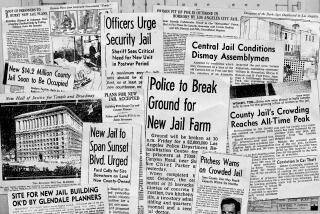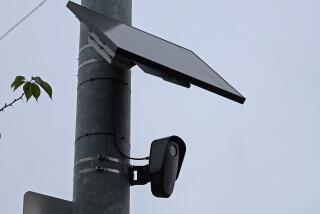County Considers Jailhouse Video Arraignments
- Share via
When the busload of prisoners pulled up to the county courthouse in July, James Michael Macias managed to slip out of his handcuffs--along with his scheduled arraignment--and bolt.
Suspected of assault, grand theft and a parole violation, the 27-year-old ran to a nearby apartment complex and tried to wrestle the car keys from a woman as she walked into her apartment.
He didn’t get far. Sheriff’s deputies, Ventura police and a hovering helicopter had Macias recaptured within minutes.
But officials say the escape highlights the security risks law enforcement officials face as up to 200 county inmates are brought to the county courthouse each day to face routine arraignment hearings. Under a new program to be considered Tuesday by the Ventura County Board of Supervisors, accused criminals in this county would soon have their first days in court without ever going to the courthouse.
Following a yearlong study, a panel of judges, public attorneys and sheriff’s officials has approved a $300,000 plan to arraign inmates by video camera from a teleconferencing room in the county’s jails.
The so-called video arraignments are being used increasingly across the nation as officials look to eliminate security risks while saving valuable time and money.
“What you’re missing is the live approach, but I’m not sure that seeing the inmate on the monitor in front of me is going to be much different than seeing him in a cage,” said Judge Barry B. Klopfer, presiding judge of the Ventura County Municipal Court.
A nine-member panel of high-ranking county law enforcement and computer officials has spent the better part of the year devising the new system. They have visited courthouses in Los Angeles, San Diego and Riverside counties to learn what works and what doesn’t, and have researched dozens of video companies.
County supervisors are expected to approve a set of routine accounting transactions Tuesday that will allow the courts and jails to purchase the cameras and monitors and begin arraigning misdemeanor suspects via video in October.
Officials will spend three months testing the new system before conducting felony arraignments by video in January. “A lot of thought and a lot of time have gone into it,” Klopfer said. “We kind of recognized that it’s a big step and we didn’t want to start off on the wrong foot, if you will.”
Inmates will be taken to special holding rooms with cameras and split-screen television monitors set up in the Todd Road Jail near Santa Paula, at Ojai’s honor farm branch jail and in the main county jail at the Government Center in Ventura.
The rooms will be linked to a judge sitting in county courtroom No. 13 and also to prosecutors in the district attorney’s office.
While inmates can decide whether to be arraigned by video or in the courtroom, research shows that 99% of the inmates will choose to remain at the jail site with their attorney, said Assistant Public Defender Jean L. Farley.
It is often humiliating and dangerous for inmates--especially those charged with sex crimes or crimes against children--to hear their charges before a group of fellow inmates taunting them from behind, she said.
Moreover, Farley said she expects inmates will trust and feel more connection with their court-appointed attorneys, and sense more one-on-one contact with the judge.
“Finally, for the first time in a year, I’ve had something good to say to the press,” Farley said with a laugh.
The main concern of the public defender’s office is ensuring fair court proceedings for clients, Farley said. The office objected to allowing prosecutors and judges to sit together in the courtroom for the videoconference, fearing it could give the appearance of a special bond, and allow the public defender and inmate to be “turned off like a bad commercial,” she said.
But prosecutors opted to handle the arraignments from a room in the district attorney’s office.
The new procedure will clearly save time and energy, said Capt. Bruce Hansen of the Sheriff’s Court Services division.
Arraignments usually take only a few minutes, he said, but transporting prisoners to and from the court takes much of a day, while posing a security risk demonstrated most recently by Macias’ escape. “He was only out of our custody for about five minutes,” Hansen said. “But it does demonstrate that there is a security risk there.”
“Video arraignment is going to allow us to pretty much keep them . . . well within our security envelope,” Hansen said.
Judge Klopfer said court arraignments can get ugly, even in Courtroom No. 11, the county’s most secure court room.
Each day, three to four rows of shackled inmates are held in a room waiting to enter their pleas of guilt or innocence, he said.
Gang signs have been thrown like confetti. And brawls have broken out in court, at times forcing deputies to unleash pepper spray that renders the courtroom unusable for hours at a time, he said.
The video equipment was designed by Court Visions of Thousand Oaks, a company selected from five finalists after an extensive search.
The equipment also will be used for videoconferences between law enforcement agencies, with security features that prevent hackers from viewing confidential transmissions, said Margie Borjon-Miller, deputy executive officer of the Ventura County courts.
More to Read
Sign up for Essential California
The most important California stories and recommendations in your inbox every morning.
You may occasionally receive promotional content from the Los Angeles Times.










